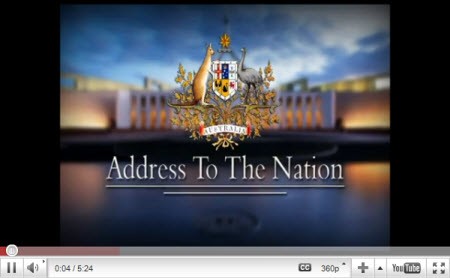Welcome to Julia Gillard’s Clean Energy Future, a world where carbon has a price ($23 a tonne) and big polluters and Joe Blow citizen will be compensated for most of the rising costs that the carbon price will cause.
”The carbon pollution reduction scheme ran into a brick wall. I’ve knocked that wall down. This is going through — full stop,” the Prime Minister emphatically declared yesterday. ”Now is the time to move from words to deeds.”
Yesterday Gillard announced the details of the much-debated carbon price, aka the Clean Energy Future policy. And it’s not just about a carbon price (although that’s the big news and will start from July 1 next year): an independent finance board will invest $10 billion over five years into renewable and low emission energy.
A Climate Change Authority, to be headed by former Reserve Bank chief Bernie Fraser, will recommend emissions targets. Industry will receive $9.2 billion in compensation to cope with the tax. The pension will rise by 1.7%. The tax-free threshold will rise from $6000 to $18,000.
You can head over to the government’s brand spanking new website to see how a carbon tax will affect your income.
For a look at all the cuts, compensation and costs, check out Bernard Keane’s list of the basics from the carbon price policy.
Gillard will be out and about desperately selling this policy in coming weeks, from a tour around Oz to an appearance as a host on Network Ten’s The 7PM Project. For a preview of Gillard’s spruiking skills, check out her address to the nation yesterday:
Tony Abbott quickly rebutted the policy, noting that it will cost taxpayers $9 billion and will impact the cost of living for middle-income families.
“The Labor-Green carbon tax will drive up prices, threaten jobs and do nothing for the environment. Australians will pay more for everything under Julia Gillard’s carbon tax — the biggest and most punitive carbon tax in the world.”
Bernard Keane wrote a great analysis of the plan yesterday for Crikey, examining the vast pros and cons. Two independent bodies will hold this policy to account, but the coal industry remains vastly overcompensated, argues Keane: “This is a better package than the CPRS it is so closely modelled on, but not by a lot.”
But how does it differ from the original CPRS plan? In another column, Keane explores the influence of the Greens and Ross Garnaut.
“You know the cliché about things designed by committee. This has all the hallmarks of being stitched together by disparate interests, which it most certainly was.”
The Greens settled for less than they were offered two years ago, argues Phillip Coorey in The Sydney Morning Herald.
“No one in government will speak openly about it, but it exists, driven by a sentiment that the minor party has negotiated and settled for a carbon price weaker in substance than the one it defeated in December 2009. And all for what?
One dumped prime minster, a hung parliament, a government on its knees and the real prospect of Tony Abbott becoming the next prime minister.”
Can Gillard sell this policy? She’ll need to because it’s got its flaws, warns The Age‘s Michelle Grattan:
“Julia Gillard faces a herculean task to sell her carbon pricing scheme. The best she seems to be hoping for is to hold the line in the early argument and then, by the time of the election, to reap some credit for ‘getting done’ a hard job.”
“This is Julia Gillard’s finest achievement as a political fixer … She has become a carbon pricer, a tax reformer and a renewable energy champion rolled into one,” writes Paul Kelly in The Australian. Not that Kelly agrees with all aspects of the carbon price plan, seeing the strong influence of the Greens as the biggest and worst asset of this policy. “It locates Australia among European nations as a climate change policy pacesetter. But is the Australian community ready to buy such values?”
The Australian’s editorial was almost glowing, relatively speaking: “Julia Gillard has succeeded where her predecessor failed, in a remarkable display of determination and pragmatism. It has brought out the best in a leader whose negotiating skills are proving to be her strongest asset.”
Gillard’s carbon tax policy is the bastard child of politics. “Australia’s latest, and probably its last, climate change scheme is the child of a marriage between unstoppable bureaucratic momentum and political desperation,” argues Alan Kohler in Business Spectator.
Labor is appealing to its old-school working-class voters with the compensation package, writes Peter van Onselen in The Australian.
“Instead, the debate over pricing carbon has become an old-fashioned showdown between two political ideologies: Labor arguing for more equitable wealth distribution, the Coalition arguing against it. Added to that is the irony that achieving Labor’s social goal is a market mechanism, which is opposed by the traditional party of market liberals. Confused yet? It’s only just begun.”
A price on carbon will put Australia on the world map. But only time will tell if it’s for the right reason, says Michael Stutchbury in The Australian:
“We’re brilliantly using our reform-era lessons to cheaply reduce our greenhouse gases by imposing a market-based carbon price across most of the economy. Or we’re recklessly shooting our wealth-creating industries in the foot to the advantage of their foreign competitors.”
This carbon price won’t be as bad or as good as the parties claim, but regardless, we’ll quickly adjust to it, opines Ross Gittins in The Sydney Morning Herald.
“Psychology sheds as much light on these questions as does economics. The safest prediction is that the tax won’t be as bad as its critics fear, nor as benign as its defenders claim.”
Andrew Bolt isn’t impressed. He argues in The Daily Telegraph that there’s something for everyone to be disappointed in. “Warming believers should be outraged that the tax is so useless. Sceptics should be outraged it’s so pointless. It offends the intelligence of everyone and threatens the jobs of thousands.”
In a scathing column in The Guardian, Aussie novelist Richard Flanagan places Australia in a global context, noting how both sides of politics in Australia have lacked guts on the climate change issue.
“The carbon tax thus looms over Australia as a large question: does Australia have the desire to move into the 21st century, or will it continue its retreat into a past as a colonial quarry for the empires of others, its public life ever more run at the dictate of large corporations, its people ever more fearful of the megafires of the future?”
Greg Jericho at Grog’s Gamut penned an interesting, graph-filled post examining the complexities of the carbon price plan, which make for good reading if you still remained confused on exactly how the whole policy works and who will be compensated. “And so now we prepare for the fight — armed with some facts and not just assumptions. Will that change the fortunes of the ALP and the LNP? Or has the battleground been set already and the voters will take the tax cuts and still stay firmly opposed to the ALP?” asks Jericho.
Battleground is the right word. The carbon price war has only just begun.









What research has Philip Coorey been doing? Sure the carbon price and compo is no better than the CPRS, but look at some of the surrounding measures that weren’t there before:
1. Taking native forest biomass out of the RET target – depriving forest industries of their only potential ‘new market’ for native forest produce.
2. The several independent authorities to make the tough decisions
3. A $1.7bn biodiversity and landcare fund
4. A huge kickstart for the renewable energy industry (and a corresponding phase out of dirty energy producers)
5. Egg on Tiny Abbott’s face
6. Oh and all the energy efficiency measures (which are the most cost effective way of reducing emissions).
7. Tax cuts for low to middle income earners – will wait patiently for the Tele and Hun to praise that element of the package.
Two years ago the electorate was screaming for the government to “do something” about climate change. So now they’ve done something, but with no real guts. There is nothing in this that will create incentives for anyone other than 500+ big polluters to change the way they produce carbon. A household heater running for one hour creates a tonne of carbon (or so I’m told) and apparently the cost of that should be $23. And we’re getting that for free???? Why???? What incentive is there in all this for households and smaller businesses to change consumption patterns? The stupid thing is that other than the symbolism of it this will not change the pattern of carbon production on a global scale one iota.
So households get ‘compensated’ for the price rises of big companies so they can pay this tax. Why hasn’t anyone looked at the obvious – that the big companies can now ramp their prices up even beyond this additional cost and leave us further in the red, under the guise of this carbon tax? Will it be transparent, or, just like the GST was, completely opaque and indistinguishable?